Bob Dylan Enters the World…by Rowland Scherman (First PC/W Staff Photographer)
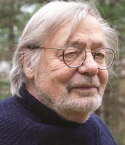 Rowland Scherman (PC/W Staff photographer 1961-64) was like any other PCV as he traveled the world, photographing PCVs at work. I met him in 1962 in Ethiopia. He would go onto become a nationally known photographer, famous for many of his photographs. This gallery of photographs by Rowland includes images of iconic figures from the 1960s, from musicians Janis Joplin and Bob Dylan, to public figures Bobby Kennedy and Martin Luther King. He has now created a website. Here is one of his first publications with a few of Rowland’s famous photographs..
Rowland Scherman (PC/W Staff photographer 1961-64) was like any other PCV as he traveled the world, photographing PCVs at work. I met him in 1962 in Ethiopia. He would go onto become a nationally known photographer, famous for many of his photographs. This gallery of photographs by Rowland includes images of iconic figures from the 1960s, from musicians Janis Joplin and Bob Dylan, to public figures Bobby Kennedy and Martin Luther King. He has now created a website. Here is one of his first publications with a few of Rowland’s famous photographs..
In his 1961 inaugural speech, President Kennedy asked us what we could do for the country; and I, like thousands of others, responded. In those days I was what one might call an “advanced amateur.” I knew what an f stop was, and the other basics, but not really much more. By answering JFK’s call, my chosen career was importantly enabled. I really was at the onset of a life in photography.
In June, 1963, I was working in Washington DC shooting PR pictures for the Peace Corps. I had been doing it since the inception of the new agency, and had literally traveled the world photographing the Volunteers at work in their newly adopted countries. I had learned quite a bit by then.
I had been to a Peter, Paul and Mary concert in DC and later heard that they were to be the headliners at the Newport Folk Festival, along with Pete Seeger, Theo Bikel, and Joan Baez, and scores of others. That sounded as if it might be fun but the main reason for my going was that that I had a huge crush on Mary Travers and I wanted to see her again.
I took a bus from Washington DC up to Newport, Rhode Island.
No ticket, no press pass.
In those days, the concerts were held in the Casino (now called the Tennis Hall of Fame). On the Friday before any of the headliner performances, around the Horseshoe Court a lot of people were milling around what was billed as the “Songwriters’ Workshop”. One of the songwriters was a 19-year old Bob Dylan and all of a sudden I was standing right in front of him. He wore a dingy shirt and around his shoulder he had wrapped a bullwhip, which I thought to be some kind of fashion statement. A fashion statement from where, I wondered. Tobacco Road? Who does that? Does he expect trouble?
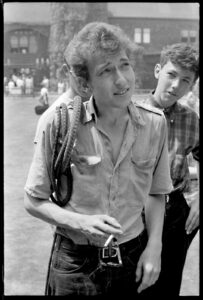
A little later the workshop began and Bob tuned up his guitar and started playing the songs he wrote. There might have been a hundred or so people in the crowd, sitting on the grass in front of the stage.
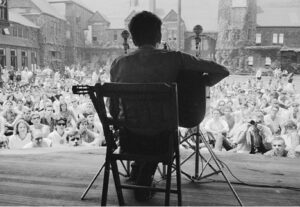
Just one or two songs into the set, folk superstar Joan Baez pulled up a chair next to Bob and started harmonizing with him. I hadn’t known they were pals, but she sure knew all his songs. The crowd immediately swelled impressively. The harmonies Joan effortlessly and beautifully inserted into Dylan’s songs gave them a gravitas few had heard before.

I went closer, shot a few frames, stage left, and pretty soon I was on the stage itself, positioning myself behind them. The only reason I wasn’t summarily kicked off the stage was, I now assume, was that I had several cameras and appeared to know what I was doing. I couldn’t help myself from trespassing. Sometimes you just know. I knew I was where I ought to be; and I was experiencing some music that was really important.
The buzz about Dylan’s duets with Joan Baez was everywhere, and everyone was asking everyone else if they’d heard it.
As if on some cosmic cue, the next night, Bob was scheduled for his own spot on the big stage. His afternoon performance the day before had stoked crowd interest in him, and there was indeed a palpable expectation throughout the festival.
I will always be amazed how coolly and confidently Dylan handled this, his big break.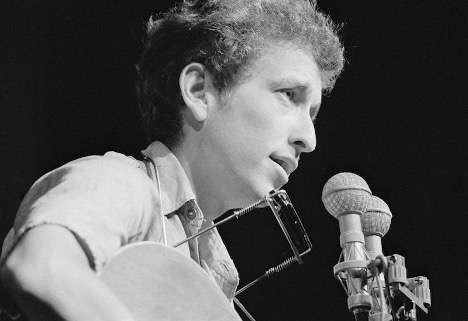
The crowd numbered in the thousands and Dylan did his stuff brilliantly—not only the mournful protest screeds about the lonely death of Hattie Carol, and other forlorn tragedies; but he also did upbeat comedic stuff like “Talking World War Three Blues.” He never missed a beat.
He had the audience in his hand right from the start. The crowd went nuts and gave him a standing ovation. Of course Dylan buzz lasted beyond, far beyond, that signature performance. .
…because on Sunday, after the headliner performance of Peter Paul and Mary singing “Blowin’ in the Wind,” he was called back on stage for an encore coda to the remarkable musical experience that preceded him. Pete Seeger, Theo Bikel, Joan Baez, the Freedom Singers, and Peter Paul and Mary were all now doing his backup vocals!
In one weekend, Bob Dylan had gone from a near unknown to the remarkable, important folk icon he’s been ever since. History was being made.
And I was lucky to be there, to make pictures of most of it.
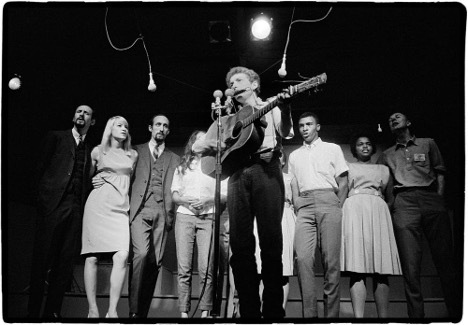
A Photographer’s Newsletter is a reader-supported publication. To receive new posts and support my work, consider becoming a free or paid subscriber.
You’re currently a free subscriber to A Photographer’s Newsletter. For the full experience, upgrade your subscription.
Thank you and thank you for recording history so well of the so-called Silent Generation – those born between 1928 and 1945,
The whole world is still singing the songs of this Silent Generation!
Fabulous photos! – such serendipitous timing – flowing right w the unplanned unexpected to-be-musical legends.
I’d like to send this to Peter Yarrow. (I’m on his board of Operation Respect.) He would love to see your photos again – as would Joan Baez whom I could also send c% Colman McCarthy whose board she is on «The Ctr for Teaching Peace.» I’m sure they would all truly appreciate the memories your photos would bring. Let me know. Sending deep appreciation for so vividly documenting such musical legends.